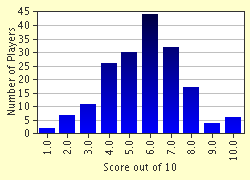Quiz Answer Key and Fun Facts
1. One of the first basics to this genre is the title, as it will grab the reader's attention. What do you think "Full Circle" by Sue Grafton is all about? (Possible spoiler answer)
2. Let's think next about the setting, where the story takes place. Some authors choose exotic locals, while others select everyday places. Setting also involves the time period in which the story takes place, as well as the occupations of the characters. All these give the story more depth and distinction, and set the stage for the action. Dick Francis writes his stories usually in a setting involving this particular business. What is it?
3. Another aspect to consider are the characters. Characters in mystery/suspense/detective stories can run the gamut from sane to cynical to dangerously psychotic and everything in between. The story will usually have a protagonist, generally thought of as the hero, or main character, and the antagonist, the villian, or the character going against the protagonist. Who is the main character in Edgar Allen Poe's "The Cask of Amontillado"?
4. Another integral component is conflict, or problem in the plot. There needs to be a problem to constitute a story. Perplexing situations such as the ones Sherlock Holmes dealt with gave an intrigue to the plot, and readers counted on Holmes' brilliant deduction skills to solve the crime at hand. Sir Conan Doyle was famous for creating Sherlock Holmes. Is it true that Doyle actually killed Holmes off since he had become sick of writing about the violin playing detective?
5. As the plot thickens, as they say, the author will often hint at what could happen later on in the story, which is known as foreshadowing. The famous girl detective Nancy Drew and her male counterparts The Hardy Boys in their ongoing mystery series had plenty of foreshadowing. Complete the title to the first Nancy Drew mystery: "The Secret of..."
6. Exposition is in the early part of the story and explains some of the important ingredients of the plot, like setting the tone, introducing the characters, and setting the overall tone of the story. John Grisham has excellent exposition in his novels that combine suspense and legal drama, due no doubt, to the fact that he was once a practicing lawyer. In what state did he first set up his practice?
7. How a story is told, the point of view used or POV,is an important element also. One of the more common POVs is third person, where the narrator is able to relate the plot in a neutral bystander tone. In many detective stories the first person POV is used, which can lend a more directness to the plot. Ray Bradbury uses the first person POV in his short story "The Utterly Perfect Murder". The murder was perfect because no one was able to find the gun Doug used on his nemesis Ralph.
8. Let's examine motive. Motive is what compels characters to do what they do, whether it be to steal, kill, or destroy someone or something, there needs to be a reason. Tony Hillerman writes about an actual event known as "The Great Taos Bank Robbery". What was the motive of the robbers?
9. Action and dialogue are also key ingredients to this genre. Action keeps a reader's interest, and dialogue helps to both move the plot and develop the characters. Agatha Christie and Dorothy Gilman each created noteworthy female crime solvers. Who would these characters be?
10. The plot will build to a climax, the turning point of the story which will lead to the resolution, where all the loose ends will be tied up. Along the way to the resolution the author might have thrown the readers a false clue to add a twist to the plot or to lead to a wrong conclusion. What is another name for a clue that seems important at the time but leads nowhere?
Source: Author
57wordsmith
This quiz was reviewed by FunTrivia editor
agony before going online.
Any errors found in FunTrivia content are routinely corrected through our feedback system.

